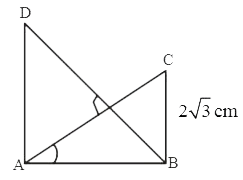A triangle ABC is right angled at A. AL is drawn perpendicular to BC. Prove that ∠BAL=∠ACB
To prove that ∠BAL = ∠ACB in triangle ABC, where triangle ABC is right-angled at A and AL is drawn perpendicular to BC, we can follow these steps:
1. Identify the Given Information:
- Triangle ABC is right-angled at A, which means ∠A = 90°.
- AL is drawn perpendicular to BC, making ∠ALB = 90° and ∠ALC = 90°.
2. Label the Angles:
- Let ∠BAL = x.
- Let ∠ACB = y.
3. Use the Angle Sum Property in Triangle ABC:
- In triangle ABC, the sum of the angles is 180°:
∠A+∠ABC+∠ACB=180°
- Substituting the known value of ∠A:
90°+∠ABC+y=180°
- This simplifies to:
∠ABC+y=90°(Equation 1)
4. Consider Triangle ALB:
- In triangle ALB, the angles also sum to 180°:
∠ALB+∠ABAL+∠BAL=180°
- Since ∠ALB = 90°:
90°+∠ABAL+x=180°
- This simplifies to:
∠ABAL+x=90°(Equation 2)
5. Consider Triangle ALC:
- In triangle ALC, the angles also sum to 180°:
∠ALC+∠ACL+∠AL=180°
- Since ∠ALC = 90°:
90°+∠ACL+∠ALC=180°
- This simplifies to:
∠ACL+y=90°(Equation 3)
6. Relate the Angles:
- From Equation 1:
∠ABC+y=90°
- From Equation 2:
∠ABAL+x=90°
- From Equation 3:
∠ACL+y=90°
7. Establish Relationships:
- From Equation 1, we can express ∠ABC as:
∠ABC=90°−y
- From Equation 2, we can express ∠ABAL as:
∠ABAL=90°−x
- From Equation 3, we can express ∠ACL as:
∠ACL=90°−y
8. Conclude the Proof:
- Since ∠ABAL + ∠BAL = 90° and ∠ACL + ∠ACB = 90°, we can see that:
∠BAL=∠ACB
- Therefore, we have proved that:
∠BAL=∠ACB
- Triangle ABC is right-angled at A, which means ∠A = 90°.
- AL is drawn perpendicular to BC, making ∠ALB = 90° and ∠ALC = 90°.
- Let ∠BAL = x.
- Let ∠ACB = y.
- In triangle ABC, the sum of the angles is 180°:
∠A+∠ABC+∠ACB=180°
- Substituting the known value of ∠A:
90°+∠ABC+y=180°
- This simplifies to:
∠ABC+y=90°(Equation 1)
- In triangle ALB, the angles also sum to 180°:
∠ALB+∠ABAL+∠BAL=180°
- Since ∠ALB = 90°:
90°+∠ABAL+x=180°
- This simplifies to:
∠ABAL+x=90°(Equation 2)
- In triangle ALC, the angles also sum to 180°:
∠ALC+∠ACL+∠AL=180°
- Since ∠ALC = 90°:
90°+∠ACL+∠ALC=180°
- This simplifies to:
∠ACL+y=90°(Equation 3)
- From Equation 1:
∠ABC+y=90°
- From Equation 2:
∠ABAL+x=90°
- From Equation 3:
∠ACL+y=90°
- From Equation 1, we can express ∠ABC as:
∠ABC=90°−y
- From Equation 2, we can express ∠ABAL as:
∠ABAL=90°−x
- From Equation 3, we can express ∠ACL as:
∠ACL=90°−y
- Since ∠ABAL + ∠BAL = 90° and ∠ACL + ∠ACB = 90°, we can see that:
∠BAL=∠ACB
- Therefore, we have proved that:
∠BAL=∠ACB
Similar Questions
Knowledge Check
ABC is a right angled triangle of which A is the right angle, BD is drawn perpendicular to BC meets CA produced in D. If AB = 12, AC = 16, BC = 20, then BD =
A15B25C10D225ABC is a triangle which is right angled at A and a perpendicular AD is drawn on the hypotenuse BC. If BC = 8 and AD = 3, then what is the value of AB×AC?
A12B24C32D36
A Δ ABC is right angled at A. L is a point on BC such that AL⊥ BC. Prove that ∠BAL=∠ACB.
View Solution. In right angled triangle ABC,∠A is right angle. AD is perpendicular to the hypotenuse BC. Prove that ΔABCΔACD=BC2AC2
View SolutionABC is a right-angled triangled, right angled at A⋅AD is drawn perpendicular to BC from A. Then AB2 is equal to
View SolutionΔABC is right angled at A, AB=3 units ,AC=4 units and AD is perpendicular to BC. What is the area of the ΔADB
View SolutionIn the figure given below , ABC is right angled at B and ΔABD is right angled at A. If BD is perpendicular to AC and BC=2√3 cm with ∠CAB=30∘, then the length of AD is___

View SolutionABC is a triangle right angled at A and AD is perpendicular to BC. If BD = 8 cm and DC =12.5 cm, then what is AD equal to ?
View Solution